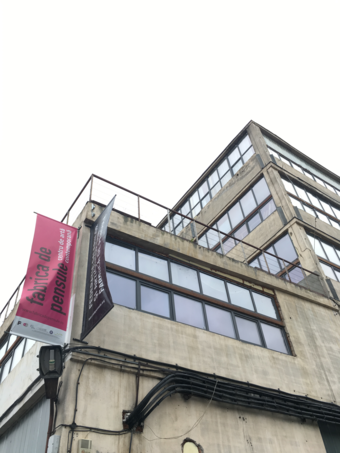Romania from the Outside
This series presents perspectives on contemporary theater in Romania. It is curated by Iulia Popovici, who recently concluded a month long ArtsLink residency at HowlRound.
“Who are you writing for?” is one of the key questions every critic should periodically ask herself. Every half-decent critic has their own answer, even if only unconsciously. Even if we cleave to a strict and unshakable sense of truth and purpose, how we choose to phrase it is always up-for-grabs. Who reads this blog, magazine, or newspaper? How many words have you got? What is your audience likely to know or not-know? What are they likely to care most about? I’m not saying that a writer should pander to their readers, but even not pandering effectively requires care and attention. These questions are thrown into sharper relief when you travel abroad to review work. Especially if your writing about the work is left on the internet for anyone to see.
Earlier this year I went to Romania, ostensibly to watch the excellent National Dance Showcase. Contemporary dance is, by and large, a wordless form. Okay, a lot of contemporary dance involves quite a bit of talking, but... The points of similarity feel recognisable, and the points of national or regional difference in contemporary dance can be appreciated in the context of increasingly globalised art forms and inform interesting comparisons. Theater is a bit different.
When I was in Bucharest, I also saw some theater. And, when I got back to Britain I had a stab at writing about it. I had already reviewed the dance pieces. I reviewed them primarily for what I understand to be my core audience (also see here and here): serious British theatergoers and theater professionals. As such, my points of comparison were largely with recent work the majority of my readers were likely to have seen, or at least read about. Because part of the critic’s job is to situate a work within the wider context of the art form. The more a critic sees and appreciates, the more accurately or interestingly they can propose where a work sits in a bigger picture, right?
In the case of the contemporary dance I saw, this turned out to be a useful, instructive, and heartening experience. The work I saw was simultaneously innovative and recognisable. It seemed to speak to work being made by my contemporaries in Britain. It suggested both surprising synchronicities and exciting new possibilities. This was less the case with the small selection of theater I saw. Thanks to the timing of the dance festival—before the new season kicked off—I only saw two “proper” productions. The other two pieces we saw were at different stages of rehearsal—which I reflected in my write up: not focusing on the production per se, but on issues which the pieces raised for me.
The thing that interested me was that three of the four shows were interview-based: one—a company working with young people—had constructed a play based on the information they’d discovered, the second company was premièring a piece which mixed archive material and speculative writing and the third company had made an out-an-out verbatim piece.
Verbatim theater is something of a button-press issue for me. In the middle of the last decade, I think it’s fair to say that Britain got a bit bogged down in verbatim theater. This was due to a variety of issues. I recently wrote a history of British theater in the last decade for the book, Modern British Playwriting and verbatim theater ended up being the opening section because of its massive proliferation across all sectors in the 2000s. Everyone from the smallest off-off- venue to the West End, taking in the National Theatre and the Royal Court along the way. Of course, like any sub-genre, some great work emerged from Britain’s immersion in the form. But at the same time, *a lot* of extremely bad work also came out. At its worst, verbatim theater encouraged a deeply damaging privileging of content over form and a repeated uninterrogated insistence on the words “true” and “real.” It also lent itself to a lot of very poor staging. As a result, when reporting back to my (I supposed) largely British readership this was the perspective from which I wrote.
The thing that interested me was that three of the four shows were interview-based: one—a company working with young people—had constructed a play based on the information they’d discovered, the second company was premièring a piece which mixed archive material and speculative writing and the third company had made an out-an-out verbatim piece.
After the post had been up a few days, I started getting notifications that it had received another comment. Quite regularly. And the reader-numbers shot up. It appeared that anyone involved with, or friends with anyone involved with those Romanian productions had turned up to read, and often remonstrate with my piece.
The first line of the first comment suggested: “Next time you visit another country and meet some artists, try to react to what you see and to the context in which the work is done and stop reducing each and every thing to what you have at home.”
Someone else was more blunt: “I think that the whole article highlights once again the typical colonial, superficial and self-sufficient look of the Westerner, full of arrogance, stereotypes, prejudices inaccuracies and faults.” (Which, of course, isn’t a stereotype at all.)
The first comment gave me more pause for thought. No, I hadn’t considered the work solely in its own context—although I had considered it in its context a good deal more than is acknowledged there. I had considered the work in relation to British work. British work which I had previously considered in relation to German and American work (two key influences on British verbatim theater were Anna Deavere Smith’s oeuvre and Klaus Pohl’s 1994 piece Wartesaal Deutschland Stimmenreich).
I had two reasons for doing so. The first reason was: to explain the work in its own context would a) not open the work up to my readers, and would b) be deeply intellectually dishonest: I don’t believe that a critic can (or should) forget everything they’ve ever seen before when they walk into a new play. Of course it compromises a critic, just as every life-experience that any given audience member has had both compromises their appreciation of a new performance and enhances it. If we truly entered theaters as a blank slate we’d be able to relate to nothing, and would have nothing to get excited about. The flip side of this is that sometimes things which might not objectively be all that annoying might annoy us anyway. It’s the same as trying to watch a party political broadcast without any politics of your own. It can’t be done. You have tastes, opinions and experiences. These are what make us who we are.
The second problem is: any other approach smacks of condescension. It is not colonial, arrogant or prejudiced to treat work from abroad in precisely the same way as you would treat work at home. Especially if it is precisely the same sort of work. Obviously you need context to appreciate the work, and I did indeed point out in my piece that given the Romanian context of course the work had its value. However, at the same time, I was also hanging out with a) a bunch of Romanians, and b) a group of artists from other Eastern European countries, who all agreed that the examples of verbatim work we saw erred toward the naïve, sentimental, or misjudged—at least at this point in their developments.
Of course I have no interest in writing off all of Romanian theater as a result of this. I would happily go and watch more. Lots more. I would love to have a more complete picture of the country’s whole theater ecology. Would doing all that make me like these particular pieces any the more, however? I suspect not. For the simple reason that I don’t think there is such a gulf between British and Romanian theater. As such, it seems perfectly possible to hold an opinion about the methodology, politics and ethics of a piece of work. Context may well be important, but can never be a shield for bad or dull work.











Comments
The article is just the start of the conversation—we want to know what you think about this subject, too! HowlRound is a space for knowledge-sharing, and we welcome spirited, thoughtful, and on-topic dialogue. Find our full comments policy here
You raise a lot of important issues not only about criticism, but how one writes criticism about art from a different culture. I have been dealing with this quite a bit over the last two years or so as I have found myself writing a great deal about contemporary plays from both Israel and Germany, and I find myself often having to discuss the cultural context (as best as I understand it, of course not being a native of either culture) that gives rise to the themes of the plays, how this differs from the American and British plays (and cultural context) to which my audience is more accustomed and why (and whether) this is relevant to an American audience.
These questions, of course, are ones with which neither Israeli nor German critics need to concern themselves when writing about Israeli or German plays for Israeli or German audiences!